| |
|
Baby Boomers & Blacks Dominate the Story:
|
| |
| |
March 20 2020
Download the PDF here
despite being often overlooked due to "the chatter" as I have maintained baby boomers prevalence is much higher than young, those born after 1969, but the young group predominates in certain states and raises concerns of growth in the future; people her what they want to hear. Still, in certain states HCV prevalence among young is growing & prevalent - see below - And Note the high prevalence in certain states for young people, those born after 1969: Kentucky, New Mexico, West Virginia, Oklahoma, Tenessee, even Pennsylvania, Lousianna, Indiana & Ohio flirts in higher range. The doubled prevalence of HCV among blacks has been persistent since the beginning of our focus on this 20 years ago, by me when I went to Congress to get HCV in the Ryan White Care Act, this has not changed reflecting the current discussions of racial & sociodemographic disparities now reflected in the COVID problem: "We also observed that modelâ€based hepatitis C prevalence was more than twice as prevalent among nonâ€Hispanic black persons than among persons of other race/ethnicities, and in 15 jurisdictions, was at least 3 times as high. This disparity has been shown previously,18 and these estimates suggest racial disparities in hepatitis C have not declined since 2010." Nothing very great has been accomplished by advocacy in Wash DC, there is no national HCV Elimination project, no national HCV testing funding, and even before the COVID problem broke out there was no indication Congress was going to do anything to address this. The USA ranks among the very last in the Globe in HCV elimination progress & predictions. Jules
Despite similar HCV prevalence, however, Hispanics have worse HCVâ€related morbidity and mortality outcomes than nonâ€Hispanic whites, including liver cancer45-47 and mortality attributable to hepatitis C.48 Liver disease is the seventhâ€leading cause of disease among Hispanics in the United States

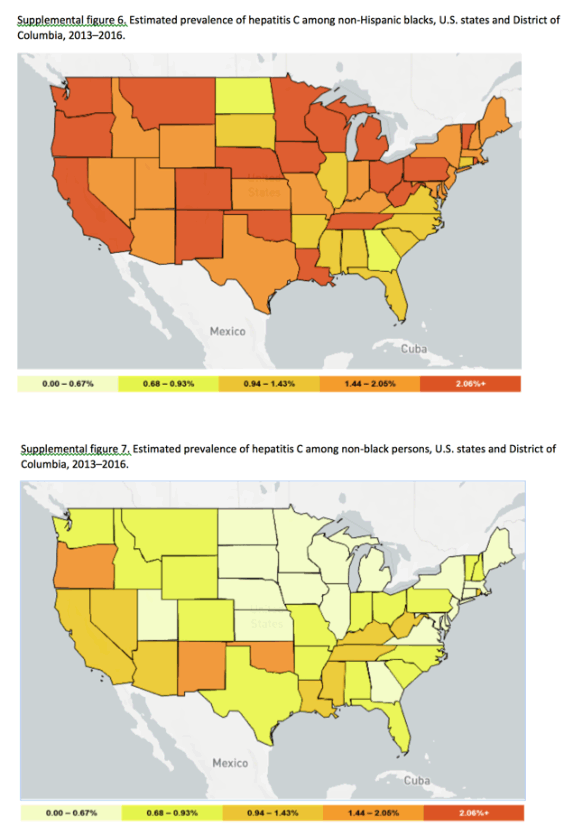
Hepatitis C Virus Prevalence in 50 U.S. States and D.C. by Sex, Birth Cohort, and Race: 2013â€2016
Modeled Hepatitis C prevalence estimates varied meaningfully by demographic characteristics, within and across U.S. jurisdictions. In most jurisdictions, we estimated higher disease prevalence among males compared with females, persons born during 1945 to 1969 compared with older or younger persons, and nonâ€Hispanic black persons compared with persons of other race/ethnicities. Reducing the overall number of HCV infections with a focus on disparities requires an understanding of both hepatitis C prevalence and number of infections in highâ€risk populations.
HCV infections are increasing among young, mostly white persons in rural areas who inject drugs,1, 24, 25 but our analysis suggests that nonâ€Hispanic blacks continue to have larger proportions of prevalent infections in most jurisdictions. Nationally, an estimated 72% of prevalent HCV infections occurred among persons born during 1945 to 1969, and even in states like West Virginia and Kentucky with higher than average percentages of infections among young people, more than 50% of all infections were still among persons born during 1945 to 1969 based on these estimates. Jurisdictions with future growth in hepatitis C burden, however, may be those with the highest prevalence of opioidâ€use disorder and associated injection drug use. This pattern begins to emerge to some extent in our results, in which many jurisdictions with higher than average overall prevalence are also those with larger percentages of infections among the youngest age group (e.g., New Mexico, West Virginia, Kentucky, Ohio).
We also observed that modelâ€based hepatitis C prevalence was more than twice as prevalent among nonâ€Hispanic black persons than among persons of other race/ethnicities, and in 15 jurisdictions, was at least 3 times as high. This disparity has been shown previously,18 and these estimates suggest racial disparities in hepatitis C have not declined since 2010. Higher prevalence among nonâ€Hispanic blacks compared with persons of other race/ethnicities likely stems from a combination of factors including lower rates of acute hepatitis C clearance,26-28 higher rates of incarceration,29-33 and less access to effective treatment services....newer directâ€acting antiviral medications provide equally effective treatment across racial groups. Efforts are urgently needed to reduce racial disparities in hepatitis C burden by increasing treatment rates among nonâ€Hispanic black Americans through improved health coverage and development of culturally appropriate care and treatment interventions.
Our findings suggest that lower HCV RNA prevalence estimates across nearly all jurisdictions, sex, and race groups compared with those previously modeled for 2010.18 Only nine jurisdictions had higher modeled prevalence in 2013â€2016 than in 2010, and many of those were jurisdictions with greater numbers of infections among young people, which may have been better detected by accounting for jurisdictional patterns of injection drug use. This difference in prevalence is likely due to a combination of hepatitis C cure and HCVâ€related mortality since 2010
Although increasing access to treatment for groups with high hepatitis C burden can decrease health disparities and reduce population prevalence, parallel interventions are needed for primary hepatitis C prevention among persons who inject drugs. Incident HCV infections have increased among young people who inject drugs due to unprecedented levels of opioidâ€use disorder.1, 24, 25, 39-41 Syringe services programs and medicationâ€assisted treatment for opioidâ€use disorder are both evidenceâ€based strategies for reducing HCV transmissions in this population.42 Mathematical models suggest that hepatitis C treatment can also reduce population prevalence among groups at highest HCV infection risk and prevent new transmissions.2, 39 In addition to development of effective interventions for delivery of these services, comprehensive care is needed for persons who inject drugs to sustain hepatitis C prevention programs.
• The highest hepatitis C prevalence by birth cohort was among persons born during 1945 to 1969, at 1.6% compared with 0.2% among persons born before 1945 and 0.5% among persons born after 1969.....Among all jurisdictions, 26% (range 8%â€41%) of prevalent infections occurred among persons born after 1969, whereas 47% (range 39%â€57%) of the population was represented by persons born after 1969 (Fig. 3). Only West Virginia had a higher percent distribution of prevalent HCV infections among persons born after 1969 versus the percent of the population represented by persons born after 1969.
• The PR for nonâ€Hispanic black to persons of other race/ethnicities ranged widely from 0.9 in Mississippi to 7.8 in Minnesota and 12.4 in D.C. [no where is the disparity for HCV greater than in Wash DC, Jules. see figure 4]. Using NHANES data alone, national hepatitis C prevalence was 0.8% among Hispanics, 1.0% among nonâ€Hispanic whites, 2.3% among nonâ€Hispanic blacks, and 0.7% among persons of other race/ethnicities during 1999 to 2016 (Table 3). Disparities were similar in 2013â€2016: 0.7% among Hispanics, 0.8% among nonâ€Hispanic whites, 1.6% among nonâ€Hispanic blacks, and 0.9% among persons of other race/ethnicities (data not shown).
• Nationally, including populations unsampled by NHANES, hepatitis C prevalence was 1.8% among nonâ€Hispanic blacks and 0.8% among persons of other race/ethnicities, with an overall PR of 2.2 for nonâ€Hispanic black to persons of other race/ethnicities (Table 4). Among nonâ€Hispanic blacks, jurisdictionâ€specific hepatitis C prevalence ranged from 0.9% in North Dakota to 4.5% in Montana and 4.9% in D.C. All but five jurisdictions had more than 1.0% prevalence among nonâ€Hispanic blacks, whereas only 10 jurisdictions had more than 1.0% prevalence among persons of other race/ethnicities. The PR for nonâ€Hispanic black to persons of other race/ethnicities ranged widely from 0.9 in Mississippi to 7.8 in Minnesota and 12.4 in D.C.
• Across jurisdictions, 23% of prevalent HCV infections occurred among nonâ€Hispanic blacks (range 1%â€91%), whereas 12% (<1%â€45%) of the population was represented by this racial group (Fig. 4). Only Mississippi had a lower percentage of prevalent HCV infections occurring among nonâ€Hispanic blacks compared with the percent of the population represented by nonâ€Hispanic blacks. Apart from D.C., jurisdictions with both a large percentage (≥30%) of prevalent infections occurring among nonâ€Hispanic blacks and large disparities (PR ≥ 3.0) among nonâ€Hispanic blacks compared with persons of other races were Ohio, Pennsylvania, Michigan, Maryland, New Jersey, Wisconsin, and Illinois.
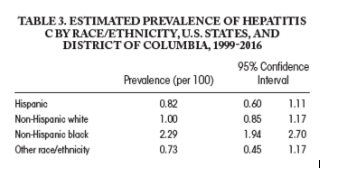
-----------------
Hepatitis C Virus Prevalence in 50 U.S. States and D.C. by Sex, Birth Cohort, and Race: 2013â€2016
March 20 200 Hepatology Communications - Heather Bradley,1 Eric W. Hall ,2 Elizabeth M. Rosenthal,3 Patrick S. Sullivan,2 A. Blythe Ryerson,4 and Eli S. Rosenberg3
From the 1 Department of Population Health Sciences, Georgia State University School of Public Health, Atlanta, GA; 2 Department of Epidemiology, Emory University Rollins School of Public Health, Atlanta, GA; 3 Department of Epidemiology
and Biostatistics, University at Albany School of Public Health, State University of New York, Rensselaer, NY; 4 Division of Viral
Hepatitis, National Center for HIV/AIDS, Viral Hepatitis, STD, and TB Prevention, Centers for Disease Control and Prevention,
Atlanta, GA.
open access
https://aasldpubs.onlinelibrary.wiley.com/doi/full/10.1002/hep4.1457
Abstract
Hepatitis C virus (HCV) infection is a leading cause of liverâ€related morbidity and mortality, and more than 2 million adults in the United States are estimated to be currently infected.
Reducing HCV burden will require an understanding of demographic disparities and targeted efforts to reduce prevalence in populations with disproportionate disease rates.
We modeled stateâ€level estimates of hepatitis C prevalence among U.S. adults by sex, birth cohort, and race during 2013â€2016. National Health and Nutrition Examination Survey data were used in combination with stateâ€level HCVâ€related and narcotic overdose–related mortality data from the National Vital Statistics System and estimates from external literature review on populations not sampled in the National Health and Nutrition Examination Survey.
Nationally, estimated hepatitis C prevalence was 1.3% among males and 0.6% among females (prevalence ratio [PR] = 2.3).
Among persons born during 1945 to 1969, prevalence was 1.6% compared with 0.5% among persons born after 1969 (PR = 3.2).
Among persons born during 1945 to 1969, prevalence ranged from 0.7% in North Dakota to 3.6% in Oklahoma and 6.8% in the District of Columbia.
Among persons born after 1969, prevalence was more than twice as high in Kentucky, New Mexico, Oklahoma, and West Virginia compared with the national average.
Hepatitis C prevalence was 1.8% among nonâ€Hispanic black persons and 0.8% among persons of other races (PR = 2.2), and the magnitude of this disparity varied widely across jurisdictions (PR range: 1.3â€7.8).
Overall, 23% of prevalent HCV infections occurred among nonâ€Hispanic black persons, whereas 12% of the population was represented by this racial group. These estimates provide information on prevalent HCV infections that jurisdictions can use for understanding and monitoring local disease patterns and racial disparities in burden of disease.
Discussion
Modeled Hepatitis C prevalence estimates varied meaningfully by demographic characteristics, within and across U.S. jurisdictions. In most jurisdictions, we estimated higher disease prevalence among males compared with females, persons born during 1945 to 1969 compared with older or younger persons, and nonâ€Hispanic black persons compared with persons of other race/ethnicities. Reducing the overall number of HCV infections with a focus on disparities requires an understanding of both hepatitis C prevalence and number of infections in highâ€risk populations.
HCV infections are increasing among young, mostly white persons in rural areas who inject drugs,1, 24, 25 but our analysis suggests that nonâ€Hispanic blacks continue to have larger proportions of prevalent infections in most jurisdictions. Nationally, an estimated 72% of prevalent HCV infections occurred among persons born during 1945 to 1969, and even in states like West Virginia and Kentucky with higher than average percentages of infections among young people, more than 50% of all infections were still among persons born during 1945 to 1969 based on these estimates. Jurisdictions with future growth in hepatitis C burden, however, may be those with the highest prevalence of opioidâ€use disorder and associated injection drug use. This pattern begins to emerge to some extent in our results, in which many jurisdictions with higher than average overall prevalence are also those with larger percentages of infections among the youngest age group (e.g., New Mexico, West Virginia, Kentucky, Ohio).
We also observed that modelâ€based hepatitis C prevalence was more than twice as prevalent among nonâ€Hispanic black persons than among persons of other race/ethnicities, and in 15 jurisdictions, was at least 3 times as high. This disparity has been shown previously,18 and these estimates suggest racial disparities in hepatitis C have not declined since 2010. Higher prevalence among nonâ€Hispanic blacks compared with persons of other race/ethnicities likely stems from a combination of factors including lower rates of acute hepatitis C clearance,26-28 higher rates of incarceration,29-33 and less access to effective treatment services.34-36 Clinical evidence suggested that interferonâ€based therapies were less effective for treating genotype 1 HCV infection among nonâ€Hispanic black versus persons of other race/ethnicities, but newer directâ€acting antiviral medications provide equally effective treatment across racial groups.37 Efforts are urgently needed to reduce racial disparities in hepatitis C burden by increasing treatment rates among nonâ€Hispanic black Americans through improved health coverage and development of culturally appropriate care and treatment interventions.37, 38
Our findings suggest that lower HCV RNA prevalence estimates across nearly all jurisdictions, sex, and race groups compared with those previously modeled for 2010.18 The two sets of estimates cannot be directly compared, because the previous estimates did not account for jurisdictionâ€level patterns of injection drug use or include prevalent HCV infections for populations unsampled by NHANES. Only nine jurisdictions had higher modeled prevalence in 2013â€2016 than in 2010, and many of those were jurisdictions with greater numbers of infections among young people, which may have been better detected by accounting for jurisdictional patterns of injection drug use. This difference in prevalence is likely due to a combination of hepatitis C cure and HCVâ€related mortality since 2010, although the analysis does not allow us to estimate how much of the difference should be attributed to cure versus mortality. Rapidly evolving patterns of hepatitis C cure, mortality, and new infections associated with opioidâ€use disorder make hepatitis C prevalence estimation particularly important to monitor through surveillance and modeling efforts.
Although increasing access to treatment for groups with high hepatitis C burden can decrease health disparities and reduce population prevalence, parallel interventions are needed for primary hepatitis C prevention among persons who inject drugs. Incident HCV infections have increased among young people who inject drugs due to unprecedented levels of opioidâ€use disorder.1, 24, 25, 39-41 Syringe services programs and medicationâ€assisted treatment for opioidâ€use disorder are both evidenceâ€based strategies for reducing HCV transmissions in this population.42 Mathematical models suggest that hepatitis C treatment can also reduce population prevalence among groups at highest HCV infection risk and prevent new transmissions.2, 39 In addition to development of effective interventions for delivery of these services, comprehensive care is needed for persons who inject drugs to sustain hepatitis C prevention programs.24, 39, 43
One important limitation of our analysis is the inability to produce separate stateâ€level hepatitis C prevalence estimates for Hispanics. Due to data sparsity in populationâ€level positive HCV RNA results by race/ethnicity, our model could stably produce stateâ€level results for two racial categories. Using the national NHANES data, we found slightly lower hepatitis C prevalence among Hispanics compared with nonâ€Hispanic whites. Previous research comparing HCV antibody by race/ethnicity corroborates this finding, with similar or slightly lower antibody prevalence estimated among Hispanics compared with nonâ€Hispanic whites.18, 44 Despite similar HCV prevalence, however, Hispanics have worse HCVâ€related morbidity and mortality outcomes than nonâ€Hispanic whites, including liver cancer45-47 and mortality attributable to hepatitis C.48 Liver disease is the seventhâ€leading cause of disease among Hispanics in the United States.49 Because this analysis aimed to describe disparities in HCV prevalence rather than outcomes, we focused on the historically18, 50, 51 and currently larger disparity between blacks and persons of other race/ethnicities. Elucidation of stateâ€level HCV prevalence and related outcomes among Hispanic populations is an important area for future research and modeling.
Our modeling approach has other limitations.7 The use of mortalityâ€based signals for jurisdictionâ€level HCV RNA infection prevalence may not capture all geoâ€spatial variation in HCVâ€related mortality and deaths attributable to injection drug use. Narcotic overdose deaths are an imperfect signal for injection drug use because of geographic variation in both types of narcotics used, how likely they are to be injected, and laws and interventions intended to reduce overdose deaths. Moreover, if underreporting of HCVâ€related mortality is differential by jurisdiction, this may compromise the reliability of these mortality estimates as a geographic signal for underlying hepatitis C prevalence. Population size and hepatitis C morbidity estimates for populations not sampled by NHANES were dataâ€informed but may not fully capture the number of HCV infections in those populations. Hepatitis C prevalence data by demographic strata are particularly limited for populations unsampled by NHANES, so assumptions based on available data had to be made for stratified estimation in these groups (Supporting Table S4). Published estimates of hepatitis C morbidity in the incarcerated population may be higher or lower than underlying prevalence, which would be better captured with routine screening. Because of the estimation methods used for unsampled populations, we were unable to compute standard errors and accompanying confidence intervals around prevalence estimates. Stratumâ€specific numbers of HCV infections in NHANES serve as the basis for modeled estimates and are more limited in groups with lower NHANESâ€based prevalence. Finally, these estimates represent prevalent rather than incident infections. Prevalent infections comprise both older and new infections, so disparities observed in these data reflect both historical disease patterns and the changing epidemiology of HCV infection. Despite these limitations, this method uses a powerful national database with biomarkers for prevalent HCV infection, wellâ€established geoâ€spatial markers of hepatitis C morbidity, nearly exact standardization to jurisdictional populations, and thorough research on populations unsampled by NHANES to produce hepatitis C prevalence estimates.
These modelâ€based estimates provide updated and comprehensive information on prevalent HCV infections that jurisdictions can use for understanding local disease patterns and allocating resources accordingly. Strengthened stateâ€level hepatitis surveillance is needed for optimal monitoring of HCV disease patterns as incident infections rise among persons who inject drugs and curative therapies become increasingly accessible. However, progress toward HCV elimination and reductions in observed disparities cannot wait for surveillance systems to mature. Modeled estimates can guide policy and programs for preventing and treating HCV infection by elucidating populations with the greatest need for intervention.
Introduction
Hepatitis C virus (HCV) infection is a leading cause of liverâ€related morbidity and mortality, and its sequelae cost billions of dollars in health care spending each year.1-3 Despite being underdiagnosed and underreported, hepatitis C is the most commonly reported bloodborne infection in the United States.1, 4, 5 More than 2 million adults in the United States are estimated to be currently infected.6, 7 Persons born during 1945 to 1965 have the highest prevalence of HCV infection, but new infections among young people are increasing due to injection drug use associated with opioidâ€use disorder.1, 6-8
When more effective, curative directâ€acting antiviral medications for hepatitis C became available in 2014, hepatitis C elimination became an imaginable goal for the first time.9, 10 States and public health coalitions have begun launching hepatitis C elimination strategies to scale up primary prevention, testing, and treatment interventions.11-13 However, hepatitis C surveillance data for monitoring progress of such initiatives are limited.14
HCV infection is a nationally notifiable disease, but chronic hepatitis C is not reportable in all states, and many acute and chronic HCV infections are undiagnosed.1, 15 The Centers for Disease Control and Prevention estimates that there are approximately 14 times more acute HCV infections than are reported as cases to national surveillance,1 and some reports suggest this may be an underestimate.16 Because of the underâ€ascertainment and lack of followâ€up in traditional surveillance systems, national probabilityâ€sample seroâ€surveys and research studies are important sources of data for estimating hepatitis C prevalence.
Previous estimates derived from one such survey, the National Health and Nutrition Examination Survey (NHANES), have quantified the degrees to which hepatitis C prevalence is elevated among persons born during 1945 to 1965, and to which disparities exist by sex and race. Men and nonâ€Hispanic blacks bear disproportionate burdens of infection.17 Monitoring and understanding these disparities is helpful for targeting efforts toward reductions in hepatitis C prevalence. Given large shifts in the epidemiology of HCV infection over the previous decade, due to changing patterns of incidence, mortality and treatment, in this paper we update and extend upon previously published stateâ€level stratified modelâ€based prevalence estimates from NHANES for 2010.18 We use multiple data sources for these modelâ€based estimates of HCV RNA positivity by jurisdiction, sex, birth cohort, and race: NHANES data (1999â€2016), external data sources that signal geographic patterns of HCV infection due to injection drug use, and literatureâ€based estimates of HCV prevalence among populations not sampled by NHANES.
Findings
Sex
Nationally, the hepatitis C prevalence estimate was 1.3% among males, ranging from 0.6% in North Dakota to 2.7% in Oklahoma (Table 1). Among females, the national hepatitis C prevalence estimate was 0.6%, ranging from 0.2% in North Dakota to 1.8% in D.C. Nationally, the PRs for males compared with females was 2.3. All jurisdictions had male:female PRs between 2.0 and 3.0 except Alaska, D.C., Wyoming (PRs < 2.0), and Maine (PRs > 3.0).
Birth Cohort
The highest hepatitis C prevalence by birth cohort was among persons born during 1945 to 1969, at 1.6% compared with 0.2% among persons born before 1945 and 0.5% among persons born after 1969 (Table 2). Among persons born during 1945 to 1969, prevalence ranged from 0.7% in North Dakota to 3.6% in Oklahoma and 6.8% in D.C. Prevalence ranged from 0.2% in Hawaii and in Nebraska to 1.7% in West Virginia among persons born after 1969. Nationally, the PR for persons born during 1945 to 1969 compared with those born after 1969 was 3.2, with jurisdictionâ€specific estimates ranging from 1.1 in West Virginia to 7.1 in Hawaii and 21.8 in D.C. The PR for persons born during 1945 to 1969 in each jurisdiction compared with the national average was 4.2 in D.C., and the PRs were also above 1.5 in Louisiana, New Mexico, Oklahoma, and Oregon. PRs for persons born after 1969 in each jurisdiction compared with the national average were above 2.0 in Kentucky, New Mexico, Oklahoma, and West Virginia.
Among all jurisdictions, 26% (range 8%â€41%) of prevalent infections occurred among persons born after 1969, whereas 47% (range 39%â€57%) of the population was represented by persons born after 1969 (Fig. 3). Only West Virginia had a higher percent distribution of prevalent HCV infections among persons born after 1969 versus the percent of the population represented by persons born after 1969.
Jules: Make note of age (1945-1969 vs >1969) prevalence differences between NY & West Virginia. Baby boomer is high prevalence in NY, much greater compared to born >1969 BUT in West Virginia prevalence rates for these 2 different age groups is similar & PR - prevalence ratio - is much greater for >1969 vs baby boomers while in NY PR is much greater for baby boomers vs born after 1969. Prevalence in Wash DC is very high for baby boomers & much lower for >1969 & much higher than in NY & West Virginia & for baby boomers compared to >1969 in W Va. And Note the high prevalence in certain states for young people, those born after 1969: Kentucky, New Mexico, West Virginia, Oklahoma, Tenessee, even Pennsylvania, Lousianna, Indiana & Ohio flirts in higher range.

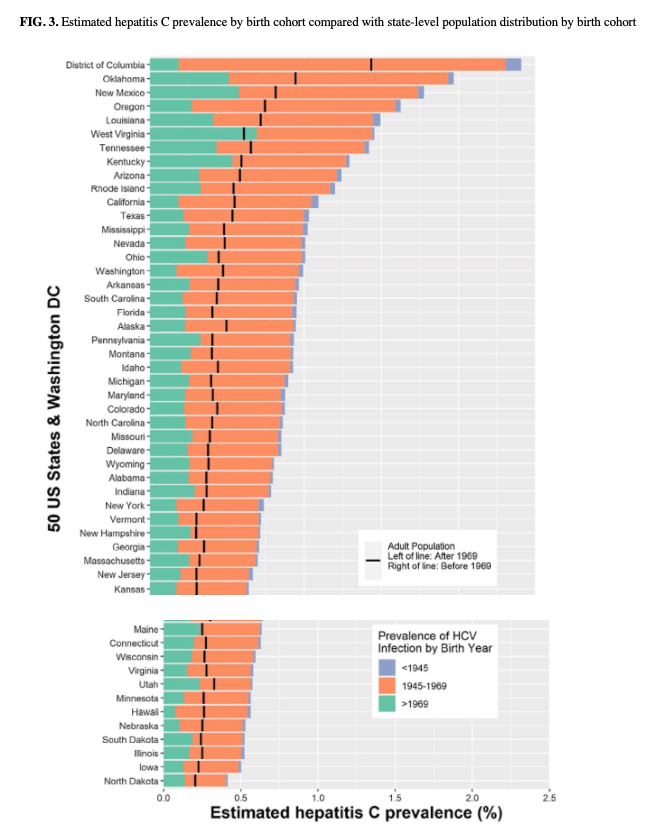
Race
Using NHANES data alone, national hepatitis C prevalence was 0.8% among Hispanics, 1.0% among nonâ€Hispanic whites, 2.3% among nonâ€Hispanic blacks, and 0.7% among persons of other race/ethnicities during 1999 to 2016 (Table 3). Disparities were similar in 2013â€2016: 0.7% among Hispanics, 0.8% among nonâ€Hispanic whites, 1.6% among nonâ€Hispanic blacks, and 0.9% among persons of other race/ethnicities (data not shown).
Nationally, including populations unsampled by NHANES, hepatitis C prevalence was 1.8% among nonâ€Hispanic blacks and 0.8% among persons of other race/ethnicities, with an overall PR of 2.2 for nonâ€Hispanic black to persons of other race/ethnicities (Table 4). Among nonâ€Hispanic blacks, jurisdictionâ€specific hepatitis C prevalence ranged from 0.9% in North Dakota to 4.5% in Montana and 4.9% in D.C. All but five jurisdictions had more than 1.0% prevalence among nonâ€Hispanic blacks, whereas only 10 jurisdictions had more than 1.0% prevalence among persons of other race/ethnicities. The PR for nonâ€Hispanic black to persons of other race/ethnicities ranged widely from 0.9 in Mississippi to 7.8 in Minnesota and 12.4 in D.C.
Across jurisdictions, 23% of prevalent HCV infections occurred among nonâ€Hispanic blacks (range 1%â€91%), whereas 12% (<1%â€45%) of the population was represented by this racial group (Fig. 4). Only Mississippi had a lower percentage of prevalent HCV infections occurring among nonâ€Hispanic blacks compared with the percent of the population represented by nonâ€Hispanic blacks. Apart from D.C., jurisdictions with both a large percentage (≥30%) of prevalent infections occurring among nonâ€Hispanic blacks and large disparities (PR ≥ 3.0) among nonâ€Hispanic blacks compared with persons of other races were Ohio, Pennsylvania, Michigan, Maryland, New Jersey, Wisconsin, and Illinois.
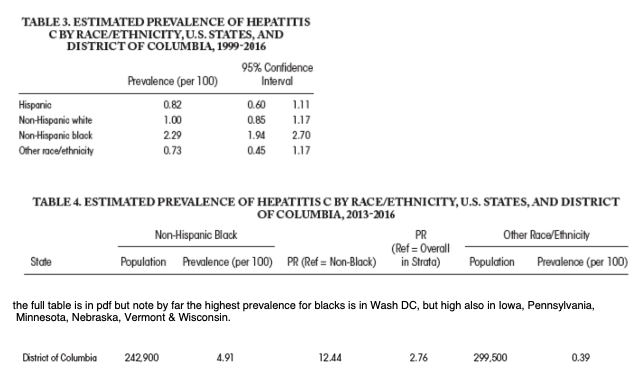
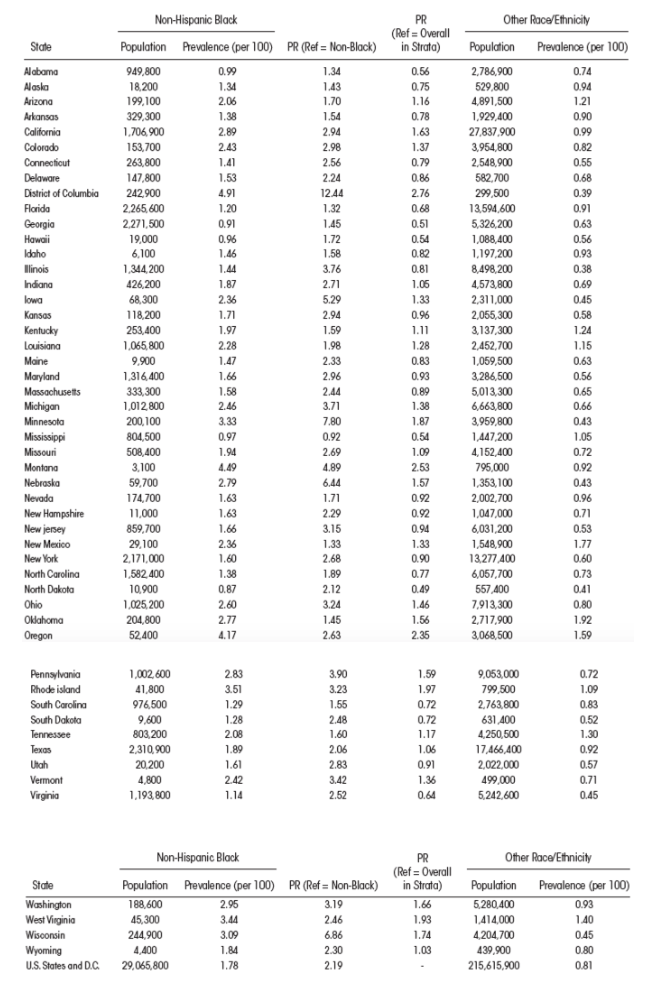
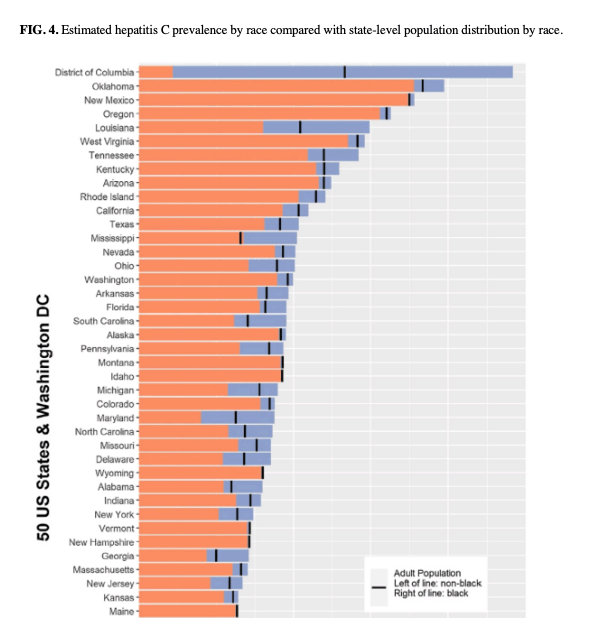
| |
| |
| |
|
|
|